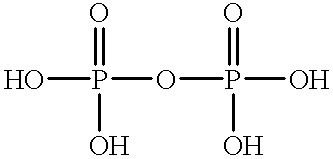High energy density vanadium electrolyte solutions, methods of preparation thereof and all-vanadium redox cells and batteries containing high energy vanadium electrolyte solutions
a vanadium electrolyte and high energy density technology, applied in the direction of non-aqueous electrolyte cells, indirect fuel cells, sustainable manufacturing/processing, etc., can solve the problems of reducing the capacity and reducing the concentration of vanadium, and reducing the energy density of the battery based on redox, so as to reduce or prevent crystallisation or precipitation, the effect of reducing or preventing the crystallisation or precipitation
- Summary
- Abstract
- Description
- Claims
- Application Information
AI Technical Summary
Benefits of technology
Problems solved by technology
Method used
Image
Examples
example 1
[0643] A 5.5M V(V) solution was prepared by electrolytically oxidising 5.5M VOSO.sub.4 in 3M H.sub.2SO.sub.4. This solution was stable for more than 2 weeks at room temperature followed by 8 weeks at 50.degree. C. When the solution was initially prepared it was very thick and viscous. This solution became less viscous however on standing. After about 2 weeks at 50.degree. C., its viscosity was almost as low as that of a 2M V(V) solution. A sample stored at room temperature however, took more than 4 weeks to reach a similar low viscosity.
example 2
[0644] SO.sub.2 may bubbled through a solution of 3 moles per liter V.sub.2O.sub.5 in 9M sulphuric acid produced 6M V(IV).
[0645] Substantially all the V.sub.2O.sub.5 powder dissolved and was reduced by the SO.sub.2 to form V(IV) ions in solution initially. By containing the SO.sub.2 bubbling the V(IV) ions were further reduced. SO.sub.2 bubbling was continued until the potential of the solution reached that of a 50:50 mixture of V(III) and V(IV) (approx. 0.3 V vs S.C.E. for 2M vanadium in 2M H.sub.2SO.sub.4), which is a suitable HED electrolyte solution for use in a practical all-vanadium battery.
example 3
[0646] An electrolyte solution consisting of 50:50 ratio of 6M V(III) and V(IV) in 9M H.sub.2SO.sub.4 may be prepared by electrolyzing a slurry of 3M of V.sub.2O.sub.5 powder in 1 liter 9M H.sub.2SO.sub.4 in a cell as depicted in FIG. 1.
[0647] The process is generally carried out with a separator between the anode and cathode. Since a separator is used, the electrolyte solution in contact with the cathode is usually continuously stirred. Cell Voltage .congruent.2.5 Volts. Substantially all the V.sub.2O.sub.5 powder dissolves and is reduced at the cathode to form V(III) / V(IV) ions in solution. The cell temperature was 40.degree. C.
PUM
| Property | Measurement | Unit |
|---|---|---|
| temperatures | aaaaa | aaaaa |
| temperature | aaaaa | aaaaa |
| operating temperature | aaaaa | aaaaa |
Abstract
Description
Claims
Application Information
 Login to View More
Login to View More - R&D
- Intellectual Property
- Life Sciences
- Materials
- Tech Scout
- Unparalleled Data Quality
- Higher Quality Content
- 60% Fewer Hallucinations
Browse by: Latest US Patents, China's latest patents, Technical Efficacy Thesaurus, Application Domain, Technology Topic, Popular Technical Reports.
© 2025 PatSnap. All rights reserved.Legal|Privacy policy|Modern Slavery Act Transparency Statement|Sitemap|About US| Contact US: help@patsnap.com



